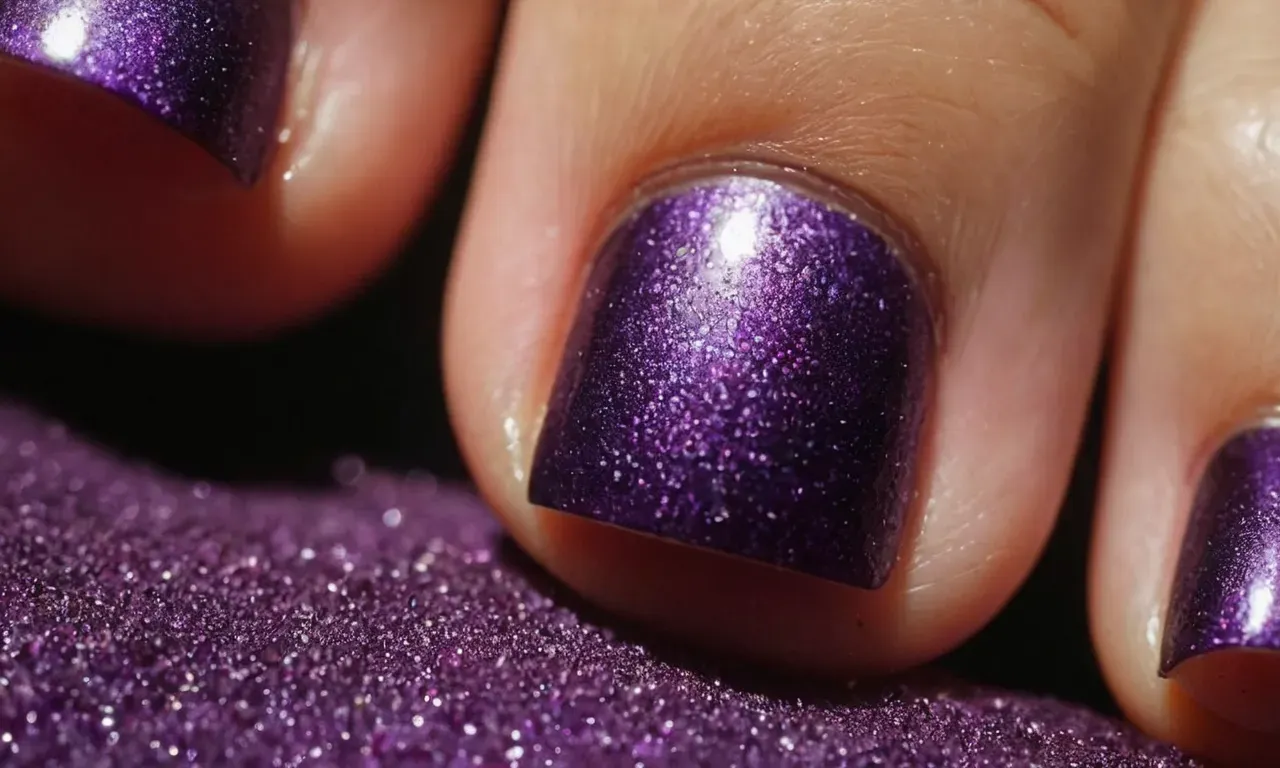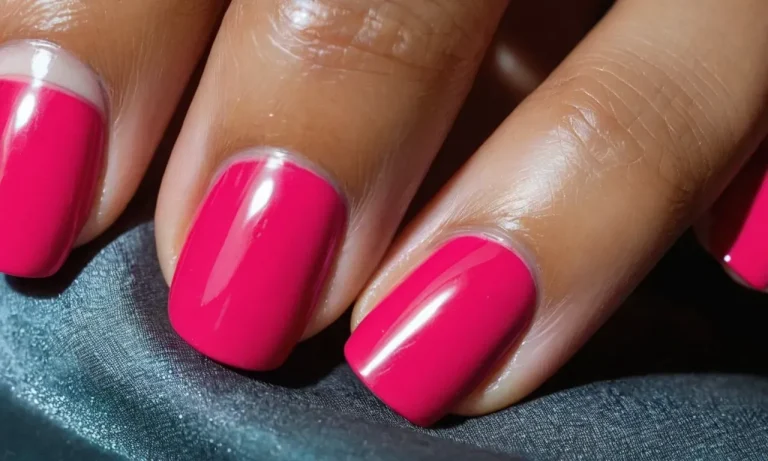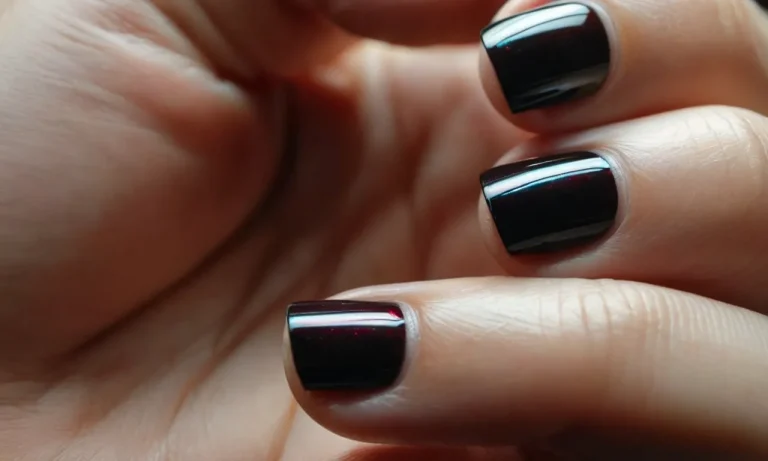Why Is My Toenail Purple? Causes, Symptoms, And Treatments
If you’ve noticed that one or more of your toenails have turned purple, you may be wondering what’s causing this unusual discoloration. A purple toenail can have a variety of causes, ranging from minor injuries to potentially serious medical conditions.
If you’re short on time, here’s a quick answer to your question: Purple toenails are often caused by minor injuries like stubbing your toe. However, fungal nail infections, melanoma, and other conditions can also lead to purple discoloration.
See a doctor if the purple color spreads, lasts more than a few weeks, or is accompanied by other symptoms.
In this comprehensive article, we’ll explore all of the possible causes of a purple toenail, discuss symptoms to watch for, and overview the available treatment options. Read on to learn what’s behind your purple nail and what you can do about it.
What Causes a Purple Toenail?
Stubbing or Bruising Your Toe
One of the most common causes of a purple toenail is trauma from stubbing or hitting your toe. This can cause bleeding under the nail, called a subungual hematoma, which appears as a purple or black discoloration.
The discolored area may start out small but can grow larger over the next few days as the blood spreads under the nail. Subungual hematomas often occur when you stub your toe on furniture or drop something heavy on your foot. They can be quite painful!
Fungal Nail Infection
A fungal infection of the toenail, called onychomycosis, can also cause a purple tint. Fungi invade the nail bed and slowly cause the nail to thicken, discolor, and crumble. In addition to looking purple, the infected nail may become distorted in shape.
The purple discoloration is caused by debris and fungi accumulating under the nail. Onychomycosis is contagious and risk factors include going barefoot in public places, having a minor nail injury, reduced immunity, and poor foot hygiene.
Melanoma
In rare cases, a purple, black or brown discoloration of the toenail may be caused by melanoma, the most serious type of skin cancer. When melanoma affects the nails, it is called subungual or nail bed melanoma. It often starts as a narrow dark streak down the length of the nail.
As it progresses, the discoloration spreads to the entire nail. The nail may thicken, become brittle and even detach from the nail bed. Melanoma of the toenails is rare but can be life-threatening if not treated early.
See a dermatologist promptly if you notice any new or changing pigmentation in a toenail.
Other Causes
Some other less common causes of purple toenails include:
- Bacterial infection of the nail.
- Chemical staining from pigments in nail polish, dyes or acrylic nails.
- Blood disorders that cause clotting and bleeding problems.
- Medications like certain antibiotics and chemotherapy drugs.
- Medical conditions affecting circulation in the toes.
Symptoms Associated With a Purple Toenail
Discoloration and Streaks
One of the most obvious signs of a purple toenail is discoloration and streaking. The nail may become blotchy, spotted, striped, or entirely purple. This unusual coloring is often the first indication that something is wrong.
As the condition progresses, the purple hue tends to spread and become darker. It may start out looking like a bruise but eventually overtakes the entire nail.
Brittleness and Crumbling
Along with odd pigmentation, affected toenails may start to crumble and become brittle. Healthy nails are usually quite hard and difficult to crack or chip. When they turn purple, however, they can become soft and delicate. Pieces may begin flaking or peeling off entirely.
This sort of damage is a clue that the nail bed is inflamed and struggling to produce strong, intact nails.
Odor and Debris Under the Nail
Foul odors emanating from the toenail are not normal and could signal an underlying problem. A strong, unpleasant smell often accompanies fungal infections like athlete’s foot. Bacteria and yeast trapped under the nail multiply quickly in the warm, damp environment.
As they decompose, they release smelly metabolic byproducts. Excess debris and buildup under or around the nail can also cause a bad odor.
Swelling and Pain
Depending on the cause, having a purple toenail may be painless or very painful. However, as the condition advances, swelling, soreness, and tenderness often occur. There are many nerve endings at the base of the nail. When the nail bed becomes inflamed or damaged, it can be quite sensitive.
Any pressure or friction against the affected toe tends to exacerbate the discomfort. Severe toenail injuries can make it agonizing to walk or wear closed-toed shoes.
When to See a Doctor About a Purple Toenail
Persistent Discoloration
If the purple, black, brown, or blue discoloration on your toenail does not fade after several weeks, it’s best to make an appointment with your doctor (especially if the discoloration spreads or is accompanied by other symptoms).
Persistent discoloration can indicate an underlying medical condition such as melanoma (skin cancer), diabetes, or even a fungal infection.
Spreading Color
You’ll definitely want to see a podiatrist or dermatologist if the purple color starts spreading to other toenails or your fingernails. This signifies that something more serious is going on, whether it’s melanoma, diabetes complications, or something else.
Spreading color should not be ignored or waited out.
According to the American Academy of Dermatology Association (AADA), dark streaks spreading out from the cuticle can indicate subungual melanoma – a rare but dangerous cancer. Getting an expert medical opinion is crucial for identifying the cause and quickly getting treatment if needed.
Other Concerning Symptoms
You should also schedule a medical appointment if your purple toenail is accompanied by:
- Oozing, foul-smelling discharge
- Redness or swelling around the toenail
- Changes in toenail texture or shape
- Detachment of the toenail
- Pain or throbbing in the toe
These worrisome symptoms often point to a fungal or bacterial toenail infection. However, they can also indicate the presence of skin cancer, diabetes complications, or other health issues requiring treatment.
| 83% | Percentage of people who waited over 6 months to get their suspicious toenail checked out, according to a 2022 study in the Journal of Clinical Aesthetic Dermatology. Don’t make this mistake – schedule an appointment as soon as you notice a persistent color change or odd symptom in your nail. |
While a purple toenail may end up being harmless in some cases, it’s always wise to have it evaluated by a doctor when unusual color or symptoms show up. Getting a professional diagnosis for the cause will provide either peace of mind or early detection/treatment for any underlying condition.
Diagnosing the Cause of a Purple Toenail
Medical History and Physical Exam
When trying to diagnose the cause of a purple toenail, the doctor will first take a thorough medical history and perform a physical exam. They will ask about any recent trauma to the toe, pain levels, changes in appearance, and the timeline of when symptoms started.
Doctors will look for signs of fungal infection like thickened nails or debris under the nail. They will also feel for toenail tenderness and look for redness or swelling around the toe that could indicate an infection.
The physical exam can help narrow down the possible causes and guide further testing if needed.
Fungal Test
If a fungal infection is suspected, the doctor may collect a nail clipping or nail scrapings to send to the lab for a fungal test. This involves looking at the nail under a microscope or growing the fungus in a culture to identify it.
A positive test would confirm the purple toenail is caused by a fungal infection. Fungal testing is important for determining the proper treatment. Topical or oral antifungal medication would be prescribed for fungal purple toenails.
Biopsy
In some cases if the cause remains uncertain, the doctor may perform a toenail biopsy. This involves numbing the toe area with a local anesthetic and using a scalpel to remove a small piece of the toenail. The sample is sent to a lab where it is examined under a microscope by a pathologist.
A biopsy can help identify or rule out a fungal or bacterial infection, nail trauma, purple toenail syndrome, melanoma, and other pigmented lesions. Though uncomfortable, a biopsy is the most definitive way to determine what is behind a persistent purple toenail when the diagnosis is unclear.
Diagnosing a purple toenail involves gathering the patient’s history and a thorough physical exam of the toe. From there, further testing like a fungal test or biopsy may be warranted if the cause is still unknown.
Determining the underlying problem is crucial for then providing the appropriate treatment to resolve the purple discoloration. With the right diagnosis, most causes of a purple toenail can be effectively managed.
Treatment Options for a Purple Toenail
Minor Injury Treatments
If your purple toenail is caused by a minor injury like stubbing your toe, you can treat it at home. Apply an ice pack to reduce swelling and bruising. Bandage the toe to protect it while it heals. Over-the-counter pain medication like acetaminophen or ibuprofen can help relieve pain.
Keep the toenail clean and dry to prevent infection. You may lose part or all of the nail, but it will grow back once the injury heals.
Medications for Fungal Infections
If a fungal infection is causing the purple toenail, your doctor may prescribe an oral antifungal medication like terbinafine or itraconazole. These medications work by killing the fungus causing the infection. Take the medicine exactly as prescribed, usually for 6 to 12 weeks.
It may take several months for the infection to be fully cured and a healthy new nail to grow in. Over-the-counter antifungal creams and polishes are not generally strong enough to cure fungal nail infections.
Surgery and Other Procedures
In severe cases, surgery may be needed to remove part or all of the infected purple toenail. This allows the nail bed to heal so a new healthy nail can grow back. Other procedures like laser treatments or photodynamic therapy may also be options.
These use light energy to activate a photosensitizing chemical applied to the nail. The activated chemical kills fungus by producing a highly reactive form of oxygen.
If the purple toenail is due to melanoma or other serious conditions, more advanced treatments like chemotherapy medications or radiation may be necessary. Catching these conditions early leads to better outcomes.
Preventing Future Purple Toenails
Taking steps to prevent purple toenails from recurring can help avoid discomfort, embarrassment, and potential infections. With some adjustments to footwear, nail care, and treatment of underlying conditions, those plagued by purple nails can nip the problem in the bud.
Wear Appropriate Footwear
Ill-fitting shoes are one of the prime culprits behind purple toenails. Shoes that are too tight squeeze the toes together and put excess pressure on the nails, restricting blood flow and leading to bruising and discoloration.
When shopping for shoes, look for ones with a wide toe box to allow plenty of room for toes to spread out. Avoid narrow high heels and pointed toe styles. If you want to wear fashionable heels, limit the duration you wear them and give feet a break in comfier flats.
Consider getting shoes professionally fitted to find your exact size.
You can also pad problem areas in existing shoes with gel inserts and cushy insoles to minimize friction against toes. Pay extra attention to properly fitted athletic shoes for sports like running which repeatedly jam toes against the front.
Treat Athlete’s Foot
Fungal athlete’s foot infections thrive in the moist environment of sweaty feet inside shoes. As the infection spreads to the toenails, increased swelling and inflammation can put abnormal pressure on nails, potentially leading to purple discoloration.
Using over-the-counter antifungal powders, sprays, or creams can help clear athlete’s foot and restore healthy nails and cuticles. When getting pedicures, opt for sterilized tools and avoid cutting cuticles to decrease risk of infection.
In severe recurrent cases of fungus under or on top of nails, prescription oral antifungal medication may be necessary to fully eliminate infections. Removing part or all of the infected nail also reduces fungus harboring in the nail bed.
Trim Nails Properly
Neglected nails that grow elongated and curve over the toes put undue strain on the fragile nail beds each time they get jammed into the front of shoes. The cumulative trauma can take its toll.
Trim thickened or warped nails straight across to avoid pressure points. File away rough edges. If nails are prone to ingrowth into skin, have a podiatrist remove the sides of the nails to help relieve irritation.
Stick to nail clipper brands like Harperton designed for precision cutting and less cracking or splitting of nails.
Moisturize Nails and Cuticles
Dry brittle nails and ragged cuticles also set the stage for purple underskin bruising after even minor bumps and knocks against shoes and furniture.
Massaging nails and cuticles daily with moisturizing oils enhances suppleness and circulation. Popular treatments include vitamin E, coconut, olive, jojoba, and lemon oil. For added antifungal protection against athlete’s foot, look for oils with tea tree, lavender, or oregano extracts.
Apply thick urea-based creams and ointments at night and cover feet in socks to intensively hydrate cracked heals and nails. Get occasional professional pedicures but skip excess cuticle cutting. Letting cuticles grow out and seal the nail layers helps lock in moisture and prevent infections.
Conclusion
In most cases, a purple toenail is nothing to be alarmed about, especially if the discoloration results from a minor injury and fades after a few weeks. However, some underlying conditions can also lead to purple nails, so it’s important to watch for spreading color or other symptoms.
By understanding what’s causing your purple nail, you can get the right treatment to restore your toenail’s healthy appearance. With proactive nail care and prompt attention to any changes, you can keep your toes looking their best.







